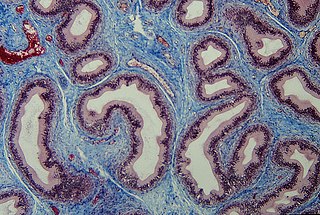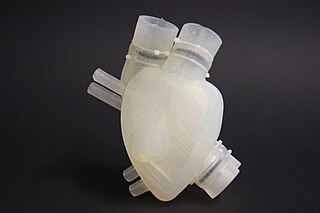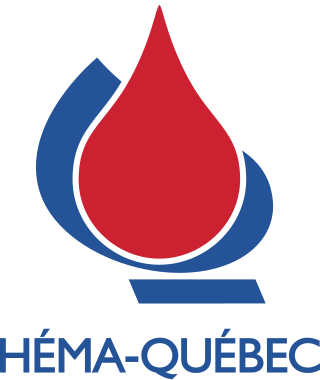Related Research Articles

The lymphatic system, or lymphoid system, is an organ system in vertebrates that is part of the immune system, and complementary to the circulatory system. It consists of a large network of lymphatic vessels, lymph nodes, lymphoid organs, lymphoid tissues and lymph. Lymph is a clear fluid carried by the lymphatic vessels back to the heart for re-circulation. The Latin word for lymph, lympha, refers to the deity of fresh water, "Lympha".

In biology, tissue is a historically derived biological organizational level between cells and a complete organ. A tissue is therefore often thought of as an assembly of similar cells and their extracellular matrix from the same embryonic origin that together carry out a specific function. Organs are then formed by the functional grouping together of multiple tissues.

In a multicellular organism, an organ is a collection of tissues joined in a structural unit to serve a common function. In the hierarchy of life, an organ lies between tissue and an organ system. Tissues are formed from same type cells to act together in a function. Tissues of different types combine to form an organ which has a specific function. The intestinal wall for example is formed by epithelial tissue and smooth muscle tissue. Two or more organs working together in the execution of a specific body function form an organ system, also called a biological system or body system.

Connective tissue is one of the four primary types of animal tissue, along with epithelial tissue, muscle tissue, and nervous tissue. It develops mostly from the mesenchyme, derived from the mesoderm, the middle embryonic germ layer. Connective tissue is found in between other tissues everywhere in the body, including the nervous system. The three meninges, membranes that envelop the brain and spinal cord, are composed of connective tissue. Most types of connective tissue consists of three main components: elastic and collagen fibers, ground substance, and cells. Blood, and lymph are classed as specialized fluid connective tissues that do not contain fiber. All are immersed in the body water. The cells of connective tissue include fibroblasts, adipocytes, macrophages, mast cells and leucocytes.

A fascia is a generic term for macroscopic membranous bodily structures. Fasciae are classified as superficial, visceral or deep, and further designated according to their anatomical location.

Arthur L. Caplan is an American ethicist and professor of bioethics at New York University Grossman School of Medicine.
The Human Tissue Authority (HTA) is an executive non-departmental public body of the Department of Health and Social Care in the United Kingdom. It regulates the removal, storage, use and disposal of human bodies, organs and tissue for a number of scheduled purposes such as research, transplantation, and education and training.
Eye banks recover, prepare and deliver donated eyes for cornea transplants and research. The first successful cornea transplant was performed in 1905 and the first eye bank was founded in 1944. Currently, in the United States, eye banks provide tissue for over 80,000 cornea transplants each year to treat conditions such as keratoconus and corneal scarring. In some cases, the white of the eye (sclera) is used to surgically repair recipient eyes. Unlike other organs and tissues, corneas are in adequate supply for transplants in the United States, and excess tissue is exported internationally, where there are shortages in many countries, due to greater demand and a less-developed eye banking infrastructure.

Organ printing utilizes techniques similar to conventional 3D printing where a computer model is fed into a printer that lays down successive layers of plastics or wax until a 3D object is produced. In the case of organ printing, the material being used by the printer is a biocompatible plastic. The biocompatible plastic forms a scaffold that acts as the skeleton for the organ that is being printed. As the plastic is being laid down, it is also seeded with human cells from the patient's organ that is being printed for. After printing, the organ is transferred to an incubation chamber to give the cells time to grow. After a sufficient amount of time, the organ is implanted into the patient.
The Center for Biologics Evaluation and Research (CBER) is one of six main centers for the U.S. Food and Drug Administration (FDA), which is a part of the U.S. Department of Health and Human Services. The current Director of CBER is Peter Marks, M.D., PhD. CBER is responsible for assuring the safety, purity, potency, and effectiveness of biologics and related products. Not all biologics are regulated by CBER. Monoclonal antibodies and other therapeutic proteins are regulated by the FDA Center for Drug Evaluation and Research (CDER).

Héma-Québec is a non-profit organization that supplies blood and other biological products of human origin to hospitals for the Canadian province of Quebec. The organization's headquarters is located in the Montreal borough of Saint-Laurent, Quebec, and it was created on March 26, 1998, as a successor to the Canadian Red Cross Blood Program and the Canadian Blood Agency on recommendation of the Krever Commission.
NHS Blood and Transplant is an executive non-departmental public body of the United Kingdom's Department of Health and Social Care. It was established on 1 October 2005 to take over the responsibilities of two separate NHS agencies: UK Transplant, founded by Dr. Geoffrey Tovey in 1972, and the National Blood Service. Its remit is to provide a reliable, efficient supply of blood, organs and associated services to the NHS. Since NHSBT was established, the organisation has maintained or improved the quality of the services delivered to patients, stabilised the rising cost of blood, and centralised a number of corporate services.
Biomedical tissue is biological tissue used for organ transplantation and medical research, particularly cancer research. When it is used for research it is a biological specimen.

Stroma is the part of a tissue or organ with a structural or connective role. It is made up of all the parts without specific functions of the organ - for example, connective tissue, blood vessels, ducts, etc. The other part, the parenchyma, consists of the cells that perform the function of the tissue or organ.

The European Directorate for the Quality of Medicines & HealthCare (EDQM) is a Directorate of the Council of Europe that traces its origins and statutes to the Convention on the Elaboration of a European Pharmacopoeia.
The Healthcare Systems Bureau is part of the Health Resources and Services Administration (HRSA), of the United States Department of Health and Human Services.
Hon. Richard Tedder FRCP is an English virologist and microbiologist, was head of the Department of Virology at the University College London Medical School, and worked as virologist at Public Health England
Following the 2010 United Kingdom general election, the UK Government under the Cameron–Clegg coalition announced plans to curb public spending through the abolition of a large number of quasi-autonomous non-governmental organisations (quangos). This was styled in the national press as a "bonfire of the quangos", making reference to Girolamo Savonarola's religiously inspired Bonfire of the Vanities.

The MSM blood donor controversy in the United Kingdom refers to the former deferral policy of men who have had sex with men (MSM) in the United Kingdom who wish to donate their blood to UK blood donation services. Since June 2021, there is no deferral period in all four home nations. This followed an announcement in December 2020 that blood donation policies specific to MSM would be scrapped in favour of personalised risk assessment based on sexual behaviour.
The Advisory Committee on the Virological Safety of Blood, often abbreviated to ACVSB, was a committee formed in March 1989 in the United Kingdom to devise policy and advise ministers and the Department of Health on the safety of blood with respect to viral infections. The scope of the ACVSB concerned areas of significant policy for the whole of the United Kingdom and operated under the terms of reference: "To advise the Health Departments of the UK on measures to ensure the virological safety of blood, whilst maintaining adequate supplies of appropriate quality for both immediate use and for plasma processing." Of particular emphasis to the remit was the testing of blood donors using surrogate markers for Non-A Non-B hepatitis (NANBH) and later on, HCV-screening of blood donors.